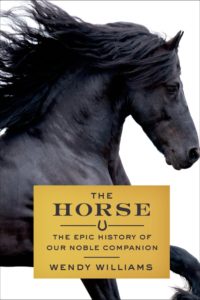I have two peeves with the otherwise marvelous new book, “The Horse: The Epic History of Our Noble Companion” by author Wendy Williams: the title and the cover.
 Neither represents what Williams warmly and intelligently covers over 305 pages (with a midsection of 19 color images). The title is all testosterone and bluster, conjuring images of Attila the Hun, Napoleon, and General Patton. The black and gold cover has a muscled, tight-lipped, over-collected, black horse. Even the font is macho and all capitals.
Neither represents what Williams warmly and intelligently covers over 305 pages (with a midsection of 19 color images). The title is all testosterone and bluster, conjuring images of Attila the Hun, Napoleon, and General Patton. The black and gold cover has a muscled, tight-lipped, over-collected, black horse. Even the font is macho and all capitals.
Thankfully, those features failed to dissuade me and I was rewarded with a personable, enlightening account of Williams’ work and travels across the globe.
A better title?
“Partners in History: Our Evolution with Horses”
A better cover?
An image of colorful, trotting ponies from cave art of thousands of years ago. Or, maybe a picture of Whisper, the clever, half-Morgan palomino that clearly had the author’s number.
Williams, 65, has had two steady pillars of interest in her life: horses and science journalism. She has ridden saddlebreds, played polo, trained in the hunter-jumper world, and ridden many miles of trails. She’s also written science-based features for scores of publications, including The Boston Globe and The Wall Street Journal.
For this book, she successfully combines those interests in a non-fiction narrative that deftly weaves personal experience with research.
“I thought [horse owners] would be interested in where their horses came from,” said Williams from her home in Mashpee, Massachusetts. “It sets their horse in context.”
 We’re not talking about a pedigree that goes back a few generations. Williams takes us back millions of years, when horses were the size of dogs, lived in forests, and were rather “insignificant” species, according to some.
We’re not talking about a pedigree that goes back a few generations. Williams takes us back millions of years, when horses were the size of dogs, lived in forests, and were rather “insignificant” species, according to some.
How they got to where they are now was not, Williams writes, “journeying toward the ‘perfect.’” Rather their path illustrated “the miracle of change on a changing planet.”
Fascinating stuff.
Williams travels to Wyoming, New Hampshire, Mongolia, France, Spain and elsewhere to explore horses past and present. In this book, she blends personal observations (especially of Whisper, the spry gelding who took it upon himself to jump a fence and turn on a spigot of water when he was thirsty one winter day in Vermont) with an exploration of the connection between horses and humans over thousands of years. She makes the argument, supported by our evolutionary paths, that horses wouldn’t exist as we know them today (and perhaps not at all) if it hadn’t been for us humans.
Thankfully, Williams largely steers clear of anthropomorphizing. Instead, she recognizes horses from a scientifically accurate and respectful point of view:
“[Whisper] was far from a machine; he was a living being with ideas of his own and with obvious decision-making abilities. But how did he make those decisions? What were his criteria? Did he enjoy some sense of himself?”
Reading Williams’ book will help you appreciate horses’ long journey to your barn and pasture. Visit her website.